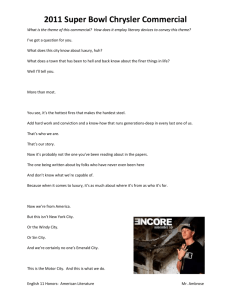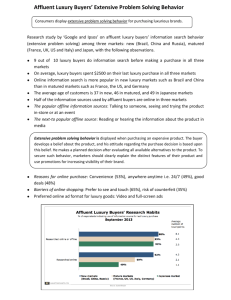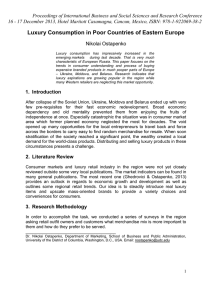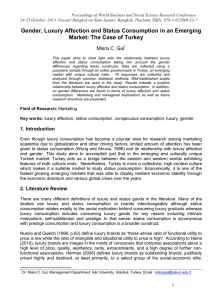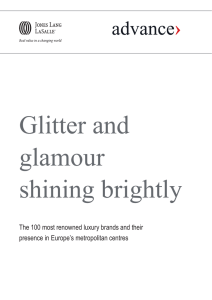INNOVATION VOCABULARY LIST: To endorse = approuver To
advertisement
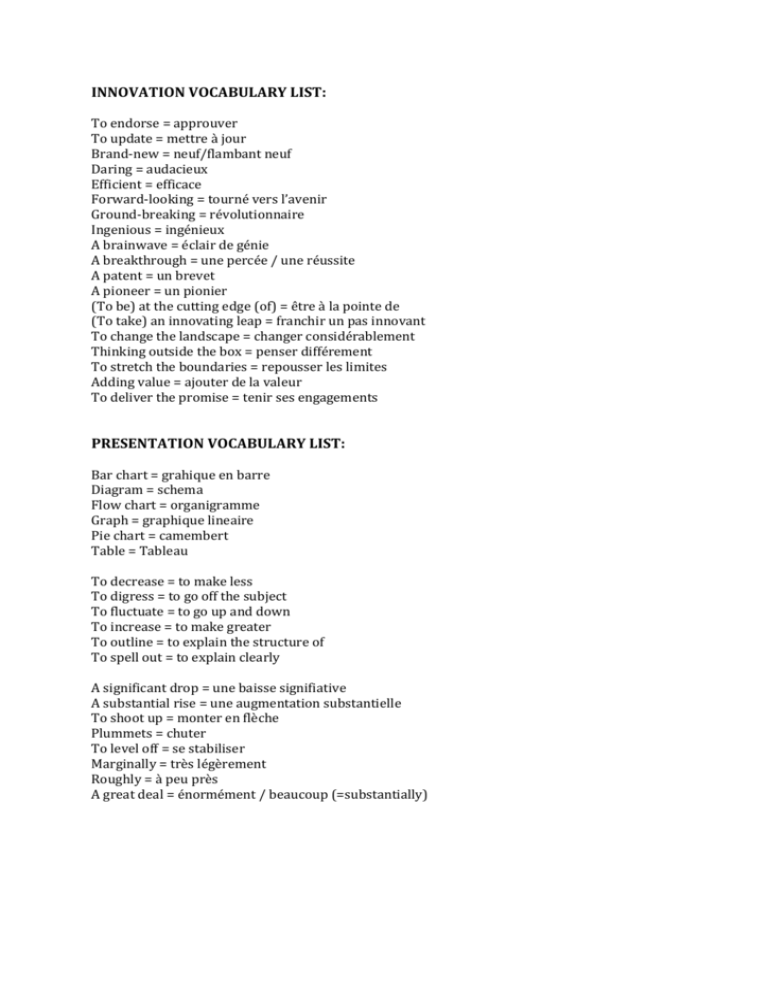
INNOVATION VOCABULARY LIST: To endorse = approuver To update = mettre à jour Brand-new = neuf/flambant neuf Daring = audacieux Efficient = efficace Forward-looking = tourné vers l’avenir Ground-breaking = révolutionnaire Ingenious = ingénieux A brainwave = éclair de génie A breakthrough = une percée / une réussite A patent = un brevet A pioneer = un pionier (To be) at the cutting edge (of) = être à la pointe de (To take) an innovating leap = franchir un pas innovant To change the landscape = changer considérablement Thinking outside the box = penser différement To stretch the boundaries = repousser les limites Adding value = ajouter de la valeur To deliver the promise = tenir ses engagements PRESENTATION VOCABULARY LIST: Bar chart = grahique en barre Diagram = schema Flow chart = organigramme Graph = graphique lineaire Pie chart = camembert Table = Tableau To decrease = to make less To digress = to go off the subject To fluctuate = to go up and down To increase = to make greater To outline = to explain the structure of To spell out = to explain clearly A significant drop = une baisse signifiative A substantial rise = une augmentation substantielle To shoot up = monter en flèche Plummets = chuter To level off = se stabiliser Marginally = très légèrement Roughly = à peu près A great deal = énormément / beaucoup (=substantially) LUXURY VOCABULARY LIST: Definition: luxury is something inessential but conducive to pleasure and comfort; expensive and hard to obtain. If not luxury : up-scale (=/ down-market), premium, top of the range, up market… 5 key trends defining the luxury industry: diversity, exception, personalisation, optimisation, and succession. Checkered = motifs (squared patterns) Craftsmanship = artisanat Embroidery = broderie Fabric = materiel / matière Fragrance = smell Fur = fourrure Garment = articles of clothing Gem = precious stone Leather = cuir Lining = doublure Man-made = fait maison Mother-of-pearl = nacre Plain = uni Scarf = écharpe Second-rate = standard Silk = soie Stitching = couture Striped = rayé Substandard = inférieur Suede = daim Tailored = sur-mesure Tweed = plaid / tweed Upholstery = rembourrage Velvet = velours Wool = laine A taint = une tare SOCIAL CATEGORIES: High Upper-middle Lower-middle Low Luxury in China: - Wealth centres are moving East - Decline of bling and rise of Craftsmanship - Niche brands are rising - Chinese brands are improving to offer equivalent quality and design to foreign brands - Sophistication - Luxury goods are bought as gifts - The wealthier a consumer is, the more likely he/she is to appreciate luxury for their innate quality and value; and the less likely he/she is to define luxury in terms of status or extravagance. Luxury in India: - Conflict between traditional values and conspicuous consumption - Growing market – no longer reserved for a privileged few - Democratization of luxury - Consumption of “bridge-brands” high = entry-level luxury. CROSSING CULTURE VOCABULARY LIST: THE WORLD’S CULTURES CHART OF RICHARD LEWIS: "Determining national characteristics is treading a minefield of inaccurate assessment and surprising exception. There is, however, such a thing as a national norm." Lewis plots countries in relation to three categories: Linear-actives = those who plan, schedule, organize, pursue action chains, do one thing at a time. Germans and Swiss are in this group. Multi-actives = those lively, loquacious peoples who do many things at once, planning their priorities not according to a time schedule, but according to the relative thrill or importance that each appointment brings with it. Italians, Latin Americans and Arabs are members of this group. Reactives = those cultures that prioritize courtesy and respect, listening quietly and calmly to their interlocutors and reacting carefully to the other side's proposals. Chinese, Japanese and Vietnam are in this group. 5 dimensions of culture: - Power distance = how people accept power/authority - Individualism = be seen as an individual, not just as a team - Masculinity = if both sexes are at the same level or not (for jobs…) - Uncertainty avoidance = anxiety felt in unknown situations (rules and regulations) - Indulgence - Pragmatism = respect for traditions THE CULTURAL ICEBERG: Culture is but one category or dimension of human behaviour, and it is therefore important to see it in relation to the other two dimensions: the universal and the personal. The three can be distinguished as follows: Universal refers to ways in which all people in all groups are the same; Cultural refers to what a particular group of people have in common with each other and how they are different from every other group; Personal describes the ways in which each one of us is different from everyone else, including those in our group. These are two important points for you to remember: Because of universal behaviour, not everything about people in a new culture is going to be different; some of what you already know about human behaviour is going to apply in your host country. Because of personal behaviour, not everything you learn about your host culture is going to apply in equal measure, or at all, to every individual in that culture. NICHE MARKETING VOCABULARY LIST: Definition: a small but profitable segment of a market suitable for focused attention by a marketer. They do not exist by themselves, but are created by identifying needs or wants that are not being addressed by competitors, and by offering products that satisfy them. Their success depends on good market segmentation They can be used with mass-market products (toothbrush, cars…) Definition of a RATCHET: An arrangement in which the value of someone's share in a company depends on how well the company performs. This is often done where company managers own a share in the company.

